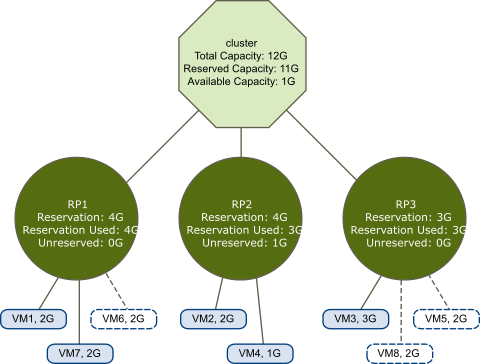A valid cluster has enough resources to meet all reservations and to support all running virtual machines.
The following figure shows an example of a valid cluster with fixed resource pools and how its CPU and memory resources are computed.

The cluster has the following characteristics:
- A cluster with total resources of 12GHz.
- Three resource pools, each of type Fixed (Expandable Reservation is not selected).
- The total reservation of the three resource pools combined is 11GHz (4+4+3 GHz). The total is shown in the Reserved Capacity field for the cluster.
- RP1 was created with a reservation of 4GHz. Two virtual machines. (VM1 and VM7) of 2GHz each are powered on (Reservation Used: 4GHz). No resources are left for powering on additional virtual machines. VM6 is shown as not powered on. It consumes none of the reservation.
- RP2 was created with a reservation of 4GHz. Two virtual machines of 1GHz and 2GHz are powered on (Reservation Used: 3GHz). 1GHz remains unreserved.
- RP3 was created with a reservation of 3GHz. One virtual machine with 3GHz is powered on. No resources for powering on additional virtual machines are available.
The following figure shows an example of a valid cluster with some resource pools (RP1 and RP3) using reservation type Expandable.

A valid cluster can be configured as follows:
- A cluster with total resources of 16GHz.
- RP1 and RP3 are of type Expandable, RP2 is of type Fixed.
- The total reservation used of the three resource pools combined is 16GHz (6GHz for RP1, 5GHz for RP2, and 5GHz for RP3). 16GHz shows up as the Reserved Capacity for the cluster at top level.
- RP1 was created with a reservation of 4GHz. Three virtual machines of 2GHz each are powered on. Two of those virtual machines (for example, VM1 and VM7) can use RP1’s reservations, the third virtual machine (VM6) can use reservations from the cluster’s resource pool. (If the type of this resource pool were Fixed, you could not power on the additional virtual machine.)
-
RP2 was created with a reservation of 5GHz. Two virtual machines of 1GHz and 2GHz are powered on (Reservation Used: 3GHz). 2GHz remains unreserved.
RP3 was created with a reservation of 5GHz. Two virtual machines of 3GHz and 2GHz are powered on. Even though this resource pool is of type Expandable, no additional 2GHz virtual machine can be powered on because the parent’s extra resources are already used by RP1.